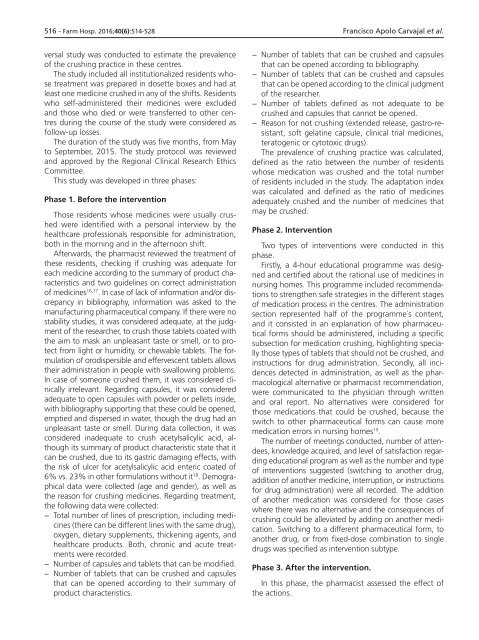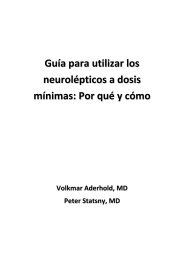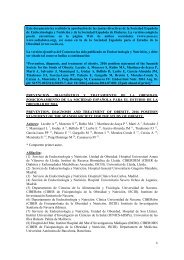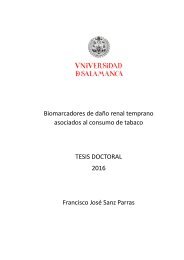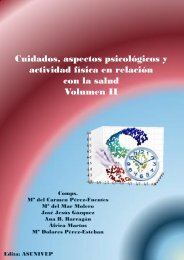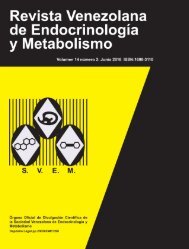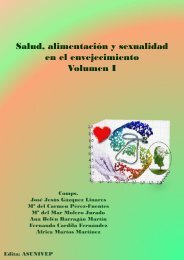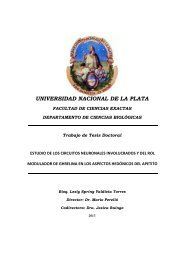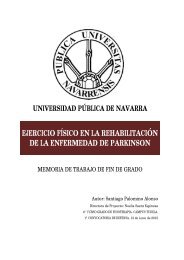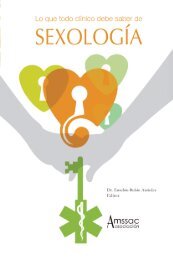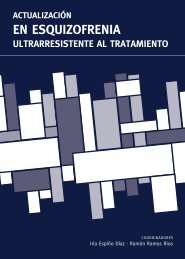Noviembre-Diciembre
156_v40n6(1)
156_v40n6(1)
Create successful ePaper yourself
Turn your PDF publications into a flip-book with our unique Google optimized e-Paper software.
516 - Farm Hosp. 2016;40(6):514-528 Francisco Apolo Carvajal et al.<br />
versal study was conducted to estimate the prevalence<br />
of the crushing practice in these centres.<br />
The study included all institutionalized residents whose<br />
treatment was prepared in dosette boxes and had at<br />
least one medicine crushed in any of the shifts. Residents<br />
who self-administered their medicines were excluded<br />
and those who died or were transferred to other centres<br />
during the course of the study were considered as<br />
follow-up losses.<br />
The duration of the study was five months, from May<br />
to September, 2015. The study protocol was reviewed<br />
and approved by the Regional Clinical Research Ethics<br />
Committee.<br />
This study was developed in three phases:<br />
Phase 1. Before the intervention<br />
Those residents whose medicines were usually crushed<br />
were identified with a personal interview by the<br />
healthcare professionals responsible for administration,<br />
both in the morning and in the afternoon shift.<br />
Afterwards, the pharmacist reviewed the treatment of<br />
these residents, checking if crushing was adequate for<br />
each medicine according to the summary of product characteristics<br />
and two guidelines on correct administration<br />
of medicines 16,17 . In case of lack of information and/or discrepancy<br />
in bibliography, information was asked to the<br />
manufacturing pharmaceutical company. If there were no<br />
stability studies, it was considered adequate, at the judgment<br />
of the researcher, to crush those tablets coated with<br />
the aim to mask an unpleasant taste or smell, or to protect<br />
from light or humidity, or chewable tablets. The formulation<br />
of orodispersible and effervescent tablets allows<br />
their administration in people with swallowing problems.<br />
In case of someone crushed them, it was considered clinically<br />
irrelevant. Regarding capsules, it was considered<br />
adequate to open capsules with powder or pellets inside,<br />
with bibliography supporting that these could be opened,<br />
emptied and dispersed in water, though the drug had an<br />
unpleasant taste or smell. During data collection, it was<br />
considered inadequate to crush acetylsalicylic acid, although<br />
its summary of product characteristic state that it<br />
can be crushed, due to its gastric damaging effects, with<br />
the risk of ulcer for acetylsalicylic acid enteric coated of<br />
6% vs. 23% in other formulations without it 18 . Demographical<br />
data were collected (age and gender), as well as<br />
the reason for crushing medicines. Regarding treatment,<br />
the following data were collected:<br />
−−<br />
Total number of lines of prescription, including medicines<br />
(there can be different lines with the same drug),<br />
oxygen, dietary supplements, thickening agents, and<br />
healthcare products. Both, chronic and acute treatments<br />
were recorded.<br />
−−<br />
Number of capsules and tablets that can be modified.<br />
−−<br />
Number of tablets that can be crushed and capsules<br />
that can be opened according to their summary of<br />
product characteristics.<br />
−−<br />
Number of tablets that can be crushed and capsules<br />
that can be opened according to bibliography.<br />
−−<br />
Number of tablets that can be crushed and capsules<br />
that can be opened according to the clinical judgment<br />
of the researcher.<br />
−−<br />
Number of tablets defined as not adequate to be<br />
crushed and capsules that cannot be opened.<br />
−−<br />
Reason for not crushing (extended release, gastro-resistant,<br />
soft gelatine capsule, clinical trial medicines,<br />
teratogenic or cytotoxic drugs).<br />
The prevalence of crushing practice was calculated,<br />
defined as the ratio between the number of residents<br />
whose medication was crushed and the total number<br />
of residents included in the study. The adaptation index<br />
was calculated and defined as the ratio of medicines<br />
adequately crushed and the number of medicines that<br />
may be crushed.<br />
Phase 2. Intervention<br />
Two types of interventions were conducted in this<br />
phase.<br />
Firstly, a 4-hour educational programme was designed<br />
and certified about the rational use of medicines in<br />
nursing homes. This programme included recommendations<br />
to strengthen safe strategies in the different stages<br />
of medication process in the centres. The administration<br />
section represented half of the programme´s content,<br />
and it consisted in an explanation of how pharmaceutical<br />
forms should be administered, including a specific<br />
subsection for medication crushing, highlighting specially<br />
those types of tablets that should not be crushed, and<br />
instructions for drug administration. Secondly, all incidences<br />
detected in administration, as well as the pharmacological<br />
alternative or pharmacist recommendation,<br />
were communicated to the physician through written<br />
and oral report. No alternatives were considered for<br />
those medications that could be crushed, because the<br />
switch to other pharmaceutical forms can cause more<br />
medication errors in nursing homes 19 .<br />
The number of meetings conducted, number of attendees,<br />
knowledge acquired, and level of satisfaction regarding<br />
educational program as well as the number and type<br />
of interventions suggested (switching to another drug,<br />
addition of another medicine, interruption, or instructions<br />
for drug administration) were all recorded. The addition<br />
of another medication was considered for those cases<br />
where there was no alternative and the consequences of<br />
crushing could be alleviated by adding on another medication.<br />
Switching to a different pharmaceutical form, to<br />
another drug, or from fixed-dose combination to single<br />
drugs was specified as intervention subtype.<br />
Phase 3. After the intervention.<br />
In this phase, the pharmacist assessed the effect of<br />
the actions.


